Magnolia Seed Harvesting
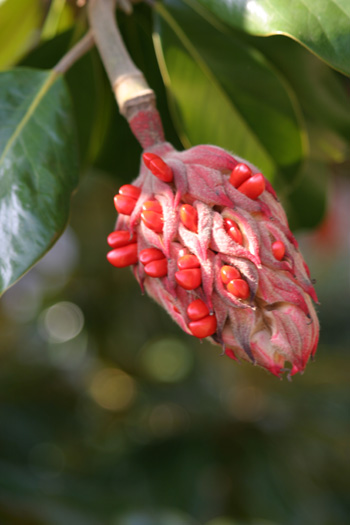 Fall is a busy time in the Wister Center Greenhouse. Volunteers work on a variety of jobs including taking cuttings of tender and tropical plants; potting up cuttings; overwintering succulent plants and this year they have been busy harvesting magnolia seeds to contribute to the Magnolia Society International’s seed exchange, The Seed Counter.
Fall is a busy time in the Wister Center Greenhouse. Volunteers work on a variety of jobs including taking cuttings of tender and tropical plants; potting up cuttings; overwintering succulent plants and this year they have been busy harvesting magnolia seeds to contribute to the Magnolia Society International’s seed exchange, The Seed Counter.
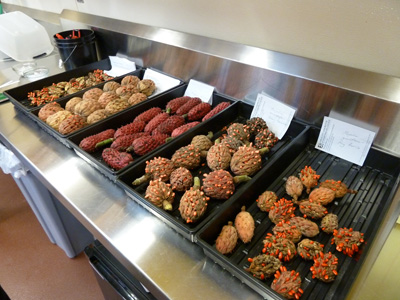
Colorful array of magnolia fruit collected from the Scott Arboretum, Henry Foundation, and Morris Arboretum. photo credit: J. Coceano
We have gathered seed from the Arboretum’s collections, as well as from the Henry Foundation in Gladwyne and the Morris Arboretum in Chestnut Hill.
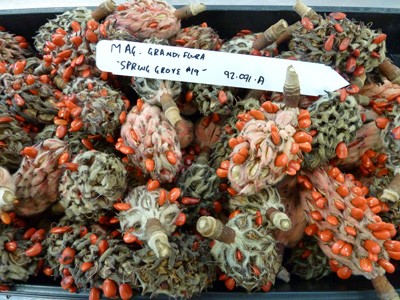
Stack of follicles bursting with magnolia seeds. photo credit: J. Coceano
Most magnolia seeds are found in large cone-like fruits called follicles.
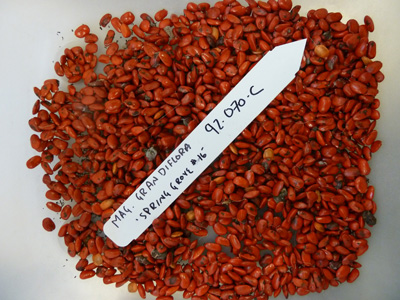
Magnolia seeds removed from follicles and ready for soaking. photo credit: J. Coceano
Once the follicles open up and reveal the seed which is often red and covered in a waxy coat, the seed can be harvested.
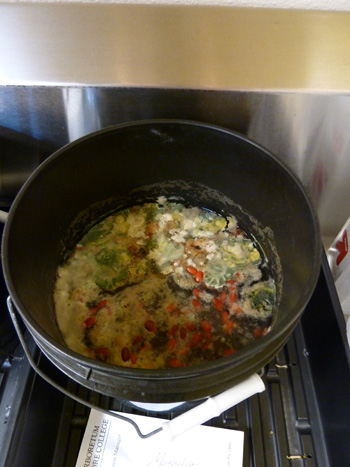
Once removed from the follicles, seeds are soaked for three days. photo credit: J. Coceano
After the seeds are harvested, they are soaked in water for three days in order to loosen the seed coat. Our volunteers found the most effective way to remove the seed from the seed coat after soaking was to squeeze the fruit. The seed simply squirts out of the fruit.
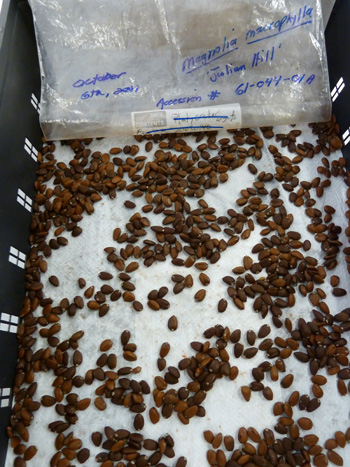
Cleaned seeds are allowed to dry for a day. photo credit: J. Coceano
The seeds are then dried for a day or two. The seeds are packaged in slightly moist vermiculite and refrigerated. Do not store the seeds dry, because they rapidly lose viability under those conditions.
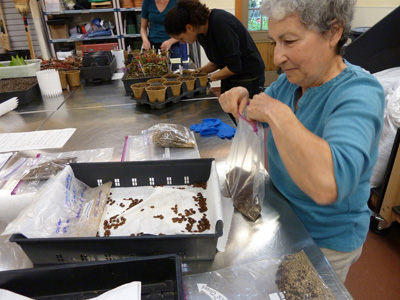
Arboretum Assistant (volunteer) Marianne DiPaulo packages seeds in moist vermiculite. photo credit: J. Coceano
The moist seeds are stratified for 2 to 4 months at 32 to 41 degrees Fahrenheit before planting. You can also fall- plant the seeds outdoors to allow nature to provide the cool, moist conditions for stratification.
Throughout the process it is important to keep the name and the source with the seed. Those who subscribe to the Magnolia Society’s seed exchange will make their selections based on species and source. To learn more about the Magnolia Society International and to participate in the seed exchange go to: www.magnoliasociety.org. Also, consider attending the next annual meeting in the Bay Area and Sonoma Valley.

As a whimsical aside on the wonders of seed germination, enjoy this video of our former summer intern, Jared Barnes impersonating our favorite super hero, Superseed. Happy propagating!





Sue Stark
Posted at 18:05h, 16 NovemberGreat pictures!
PS Jared’s not just a seed. He’s a nut!
Becky Robert
Posted at 08:50h, 17 NovemberHe will definitely be a nutty professor some day. hahaha
vicki fox
Posted at 12:13h, 23 JanuaryHi
I am an artist in Maine where I make rustic creations. I like using these magnolia seed pods which I collected when I used to live in PHila but I haven’t been able to identify nor have I found any growing up here. I have an image of them but I don’t seem to be able to include it in this email format…can you tell me where I can senbd it so you can see it? Also, Can you tell me what they are and do you know where there are some of these trees growing so I can search out the pods next fall? Do you have them at Scott Arboretum or somewhere nearby? I THINK its m. Kobus…
Thanks so much for your thoughts!
Vicki Fox
Green Team Gardeners
207.422.2324
215.205.9949
Jan
Posted at 19:04h, 30 Januarydone with the harvesting and they’ve been in the fridge since november. but where do i plant them? just in the ground outside (live in vancouver, bc), or in a pot in the house first?
help, please and thank you!
Andrew Bunting
Posted at 08:36h, 31 JanuaryThe seeds should either stay in cold storage until the spring or you could plant them in pots now and put them outside for the winter. It will be important to have to pots protected from rodents however. In the spring the seedlings should start to germinate and you can then separate them out into individual pots.
Andrew Bunting, Curator
Vinh Nguyen
Posted at 03:23h, 21 AprilHi,
I’m in Vietnam and I’m interested in collecting the different cultivar of Magnolia Grandiflora. I wonder where can I get these seeds? I tried the magnolia society link you provided but it’s not working.
Many thanks for a great post on seed collection.
Vinh Nguyen
Andrew Buting
Posted at 09:29h, 19 JuneVinh,
To get Magnolia grandiflora cultivars you will need cuttings.
Andrew
T. Tillman
Posted at 15:40h, 30 JulyI live in Southwest Florida. I am waiting on my follicule to open. Do I need to put them in the fridge for 2-4 months? When should I plant them, Fall?
Andrew Bunting
Posted at 07:34h, 31 JulyThey can be direct sown, but may take longer to germinate.
Cheryl Bolt
Posted at 07:24h, 03 SeptemberSo, in SW Florida they do not need to be refrigerated and can be planted in any season?
sara
Posted at 18:42h, 03 SeptemberHey i live in springfield mo and have always wanted a magnolia tree. my husband brought a pod home but its not bursting with the red seeds. can this be planted or is there anyway to extract the seeds for germination?
Andrew Bunting
Posted at 10:38h, 04 SeptemberThere needs to be red fruits for you to get set. Then the seed can be extracted and planted.
Andrew Bunting
Posted at 10:38h, 04 SeptemberSeed in SW Florida can be directly sowed.
julie green
Posted at 12:18h, 10 SeptemberI have been given a magnolia tree last year.It has flowered for the both years but I have not seen any seed pods. Could it be I will never get seed pods because I live in zone 4?
Gregg
Posted at 16:52h, 01 OctoberSara, I also brought a pod home early before the seeds were showing.So I decided to do a little experimentation, as I love to do when cultivating and sure enough it worked. If there’s still enough of a stem on it cut the bottom 2-3 inches off a pint spring water bottle fill with enough water to come up the stem about an inch or so place in a good sunny window in 5-7 days the red seeds will pop like it’s still on the tree. If urs is already dried out might not work. But just grab another fresh pod off a tree and get going.
Paula Reif
Posted at 19:39h, 30 OctoberI live in so Indiana and have a magnolia tree full of seeds in my yard. I want to use the red seed for beads, but have not found anything to keep them hard and bright red.
I’ve sprayed them with polyurethane , but once I poke the hole to string, they start turning black.
Any ideas would be appreciated.
Thanks, paula
Art
Posted at 17:35h, 18 JanuaryHow often do the pods fall from the tree? They are very difficult to rake, not able to use the blower to move them.
Andrew Bunting
Posted at 08:55h, 21 JanuaryMy experience is that once the outer seed coat starts to dry that it will ultimately turn black. I don’t know how to preserve the red color.
Andrew Bunting, Curator
Jan
Posted at 17:29h, 06 JulyQuestion: How ripe do the pods/cones have to be before I can remove them from the tree, or do I have to wait for them to drop? I am competing with a squirrel & bird population who seem to always be able to get to them before I do! Can I take them off while they’re still green, and ripen them artificially in an area not accessible to the critters? Thanks in advance!
Andrew Bunting
Posted at 09:59h, 08 JulyOnce they begin to open and show a bit of the ripe seed then you can harvest them.
Andrew Bunting, Curator
Stephanie Howser
Posted at 13:29h, 25 SeptemberDid anyone figure out how to use the pretty red seed as jewelry and not turn black? stephowser@yahoo.com
Andrew Bunting
Posted at 13:33h, 25 SeptemberI think it is difficult since red flesh quickly turns to black.
Andrew Bunting, Curator
Gabriel Mendoza
Posted at 15:37h, 11 OctoberI have Magnolia Grandiflora Seeds for sale. I can ship them worldwide.
Email for more information
sesutara@yahoo.com
Mary McCandless
Posted at 13:55h, 24 SeptemberWe have a large magnolia tree in our front yard. These last few days we have picked up 70 a day. We have been throwing them away. Seem like a big waste to me. I would gladly save them if somebody near by has a use for them. I live in Gulfport,MS. One year my Dad picked up close to 2000 of them.
Becky Robert
Posted at 07:56h, 29 SeptemberThank you for sharing Mary. I hope someone can put them to good use. Otherwise they look great in wreaths and holiday decorations.
Sincerely,
Becky
Christine
Posted at 14:03h, 03 OctoberMy Mongolia tree only grows these pods with red berries Will it ever bloom the white flowers? I am so disappointed.
Mary Tipping
Posted at 04:15h, 07 OctoberSeeds are only produced after a plant has flowered, so it some point your Magnolia did flower.
Cheryl H.
Posted at 15:08h, 18 OctoberMy seeds are red but when I get into them to get the inside seed out its a reddish orange and not black. Do I need to let them ripen more?
Janie
Posted at 09:51h, 21 Octoberyour pictures and info are much appreciated thanks.
I live in the northwest of England, (Cheshire, good farming land) and my Magnolia Stellata has provided seeds for the first time in 8 years and I’m hoping to grow them for family and friends. Its now October here and I’ve just harvested the small cones with red seeds nestling in them I will follow your info as to how to get the seeds out etc, me question to you is; when should I plant them, winter is just around the corner and predictions for the U.K say we’re in for a long whiteout winter. Can i store the seeds until spring if so how do I stop them from drying out or deteriorating in moist conditions until spring? Thank you in advance for any help
Josh Coceano
Posted at 07:39h, 22 OctoberMagnolia seed has the best germination rates when harvested, cleaned, and sown as soon as possible. Fresh seed is the way to go! Magnolia stellata needs a cold period (at least 2 to 3 months) for germination. I sow freshly cleaned seed in rounds (multiple seeds per pot) and place in a critter-proof frame outdoors (chipmunks, squirrels, and other animals love to eat the seed and/or dig through the rounds to bury their nuts). Come spring you should be rewarded with young stellata seedlings. The Reference Manual of Woody Plant Propagation by Dirr and Heuser, Jr. is a great resource as is the Magnolia Society International website. Happy germinating!
Nita
Posted at 06:59h, 10 DecemberHello, now that after years of trying I’ve actually pulled of germinating and growing my tiny little trees, can you tell me whether they can stay outside in the winter (I live near Boston, MA) or should I bring them in? Thanks.
Becky Robert
Posted at 09:20h, 30 JulyIf you place them in a pot that will not freeze, your plant should be good outside. You can place them in a cold frame to help with overwinter.
Sincerely,
Becky Robert
Scott Arboretum
Lily N.?
Posted at 03:43h, 07 MarchHi just wondering if the flower has to be pollinated to produce seeds because my neighbours tree has only had one seedod that made seeds. I know that most flowers need to be pollinated to do this and i was hoping that i could hand pollinate them.
Thankyou!
Kim
Posted at 19:10h, 03 AprilI found some dried seed pods in the woods around my house in WV. I guess these are called Mountain Magnolia. I don’t think they are very common as wild trees in this area. I am so excited to wait for the trees around the pods to bloom and possibly get some fresh pods this fall. Any advice is appreciated!
Burch
Posted at 09:50h, 28 AprilI have a large old magnolia in my yard and its blooming and dropping seed pods right now. I’m a little confused because they’re either green pods, with soft green seeds inside (if broken up) or brown with flat dried up looking seeds. Neither are showing red seeds. Will it work to break open the green pods and plant the green seeds or is there another time of year when it’ll produce pods with red seeds? Thanks!
Joanne
Posted at 07:25h, 07 OctoberI live in Texas and am going to try to grow some magnolia trees from seed. I just brought in two pods and removed the red coating and was surprised to see that my seeds were tan not black. Will they turn black as they dry? Is this a different variety perhaps?
Thanks!
Mary Tipping
Posted at 14:11h, 11 OctoberWhat species of Magnolia did you get the seeds from?
Josh Coceano
Posted at 09:16h, 25 OctoberHi Joanne,
Each species of Magnolia seed varies ever so slightly in color. Tan, light brown, and gray seeds all occur. The trick for successful sowing and germination is to sow seed immediately after removing the fleshy red fruit (or refrigerate until you can sow). Cleaned magnolia seed doesn’t like to dry out. Good luck!
Anonymous
Posted at 16:40h, 22 MarchGood job. It’s a great article.
Joey Lomonaco
Posted at 09:03h, 21 OctoberHi there, im planning on growing magnolia from seed indoor to start them with special growing LED lights.
I want to know if it is possible to harvest seeds from fruits, soak them in luke warm water for 24-48 hours, remove the outer shell of the seed and plant them directly without putting them throught stratification process?
Thanks a lot
Jack
Posted at 02:56h, 20 SeptemberHey,
Nice article I just want to know How to get pink magnolia flowered plant which method or trick should I use ?
Thanks
Natalie Bomberger
Posted at 17:11h, 09 NovemberI have what I believe is a lemon magnolia. That’s what I was told 5 years ago when I moved to the property. It’s probably close to 30 years old and is a very pretty tree. but I have a few concerns/questions about its health. Beautiful show of flowers this spring as always. 1) Then, it was inundated with spotted lantern flies this summer, which began as nymphs by the thousands. By the time we got advise and scheduled treatment by a local arborist, the nymphs were becoming young adults. We trapped plenty. and the tree was treated. However, 2) the tree showed sign of a large blotching/single spot on a significant number of leaves in the late summer, and 3) no seed pods this year….not one. Most years we pick up buckets and buckets of the fruit, which resemble thin pinecones or cucumbers. Possibly unrelated, 4) the tree has numerous vertical splits in the bark this year. This appears to have happened in the past prior to our ownership, because we can see plenty of older splits which have scarred over. Just wondering if this tree is dealing with too many stresses this year. I don’t mind no having to deal with the chore of picking up the pods, but this seems to be a necessary part of the tree’s growing cycle. We live in southeastern Chester County, Pennsylvania.
David McKeon
Posted at 04:32h, 19 JulyI have grown a variety of trees trees from seed . I have grown orange trees, avocado, mango, lime, lemon, and even oak trees. If you know how to germinate the seed, you can replenish the tree population in a matter of a few years. Many seeds have to be refrigerated before they will produce a tree. Some have to be planted in the fall. Some of the seeds like mango, have a shell like pod that has to be pierced without damaging the seed inside, to be able to grow. All trees have seeds. all plants have seeds. If you do not have any trees of the species you want to start, go to the grocery store and buy the fruit the tree produces. There you can get the seed you want in many cases. Most of the time it has already be germinated, which is done by placing it in the refrigerator for a few months.